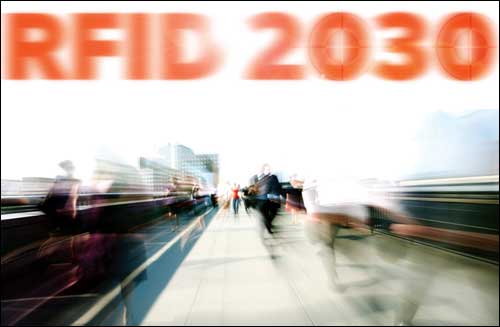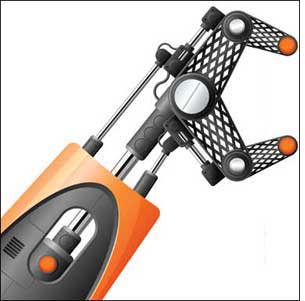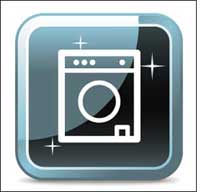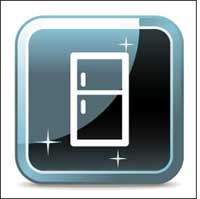Dec 01, 2009All CEOs wish they had a crystal ball, so they could see the future and prepare for it rather than simply react to change. Unfortunately, there's no way to know what the world will be like in, say, 20 years. But we believe radio frequency identification will be widely adopted by 2030 and will have a profound impact not just on the way companies do business, but on the way people shop, travel, learn and more.
Exactly how this growth will take place isn't clear, but there are signs. Technology providers that promote the benefits of RFID and deliver solutions to solve specific business problems, providing a fast return on investment, will lead the way. At the same time, companies that use the technology—to track assets and inventory, streamline operations and business processes, or provide customer services—will create and leverage an RFID infrastructure to achieve even more benefits.
In the scenarios on the following pages, we imagine what the world will be like in 2030. Read them, then ask yourself where your company will be 20 years from today. Will you be powering or using the solutions that attract shoppers to retail stores, expedite product shipments, put the joy back in travel, enhance education, simplify chores and save lives? Or will you be playing catch-up?
* * *
Since starting my Sandwich Generation blog, I've shared legal, medical and financial tips that have kept me sane while I care for my aging mother and three young children (not to mention my husband, the dog and the goldfish). For this week's entry, I'll share the real secret to juggling work and home: intelligent household tools. They're well worth the investment, and prices are dropping, making them a must for any caregiver buried under an avalanche of daily tasks. They enable both your parents and your kids to have some independence while you have the peace of mind of knowing they're safe and the chores are getting done.
Here are the smart appliances and systems that have made a huge difference in our lives. What works best for your family? Please add yours to the list.
In a household of six people, there is always dirty laundry (and I'm not referring to embarrassing family secrets). The piles used to grow, taking a back seat to doctor visits, work, errands, homework, music lessons and other appointments, until my husband and kids complained they were out of socks and underwear. Now, thanks to the Genius Laundry System, my house is neater, and there's no whining that someone's favorite jeans are dirty.
When we bring clothes into the laundry room, the Genius reader that sits atop the washing machine reads the small product identification labels the manufacturer has imprinted on each article of clothing. A screen on the reader flashes instructions for laundering each item, based on the fabric content, so no one has to think too hard when sorting the laundry. If your children can't read yet, you can set the reader to Kid Mode so it flashes pictures instead of words. (My 7-year-old loves to do the laundry!)
Once the clothes are sorted and a pile is loaded into the machine, information about load size and fabrics is transmitted to the Genius dispenser system, which measures out the appropriate amount of detergent, bleach and fabric softener. This automatic dispensing prevents spills and ensures that just the right amount of each product is applied to each load. The dispensing system also has built-in sensors to detect when the supplies are getting low—at that point, an alert is e-mailed to my shopping list. (It's frustrating when you finally find time to do the laundry, only to realize you've run out of detergent.) The system automatically selects the appropriate water temperature and starts the wash cycle.
If you're like me, your laundry can live for days in the washer or dryer. So six months ago, we purchased the Laundry Valet, a robotic helper that moves the laundry from the washer to the dryer and then folds it once it's dry. We attached tiny identification stamps to our clothes and use the reader that comes with the valet to program the chips with information about where the clothes belong. The valet, which the kids have named "Ziggy," reads each stamp as it sorts and folds our dry clothes; then it delivers the clean laundry to the appropriate room. But it doesn't stop there: Ziggy even puts the clothing in the correct drawer or closet. My husband and I joke that Ziggy should receive the Nobel Peace Prize for the harmony and order he's brought to our family.
Throughout my mother's life, cooking and entertaining have been her driving passions. Sadly, though, over the years, her failing eyesight and arthritis started making even simple tasks difficult—finding the correct whisk or looking up a recipe became tough. She was cooking less and becoming depressed. But her spirits perked up when we installed General Appliance's Smart Kitchen, designed to automate food preparation and cleanup.
The way the system works is pretty simple: Identity stamps, similar to those attached to our clothing, are fixed to all dishes, pots, cooking utensils and food items in our kitchen. We program the stamps with information describing where in the kitchen the item belongs. Our kitchen robot, which my mother affectionately named "Julia," reads the stamps, so she knows where everything belongs. Julia responds to voice commands such as "set the table" or "unload the dishwasher," and is able to find what she needs to carry out the tasks. She can also look up recipes online and display them in large type on a screen built into her front panel.
When my mother selects a particular recipe, Julia transmits the cooking instructions to the stove or oven and sets the proper temperature. The stamps on the pots and pans communicate with the range in real time, so any adjustments to the temperature or cooking time are made as needed. When cooking or baking is finished, the stove or oven shuts off automatically.
Our Smart Kitchen includes a refrigerator that monitors the freshness of produce, dairy, fish and meat, and sends an e-mail alert to my mother and Julia when, for instance, a bag of carrots nears its expiration date. Julia tracks all our food and suggests recipes based on what ingredients we have on hand, and what we need to use before they go bad. The refrigerator also will send an alert to our shopping list if, say, a milk carton is nearly empty.
I can't say enough good things about our Smart Kitchen. It's enabled my mother to reclaim her passion for cooking, it saves us a huge amount of time and money—and it keeps our family well fed.
I usually work from an office on the top floor of our house, which has its pluses and minuses. It's nice and quiet, but I can't see or hear my mom or kids when I'm up there. My husband works out of the house and travels frequently on business. So to keep track of everyone, especially when I'm squirreled away upstairs or working off-site, we use Freedom Bracelets, which let us monitor their activities while allowing them some privacy.
The wrist bracelets interact with the items around the house that we've tagged with identity stamps. My mother's bracelet records and interprets her movements based on what objects she uses and where she is in the house. That information is displayed on the Freedom View, a 5-by-7-inch screen designed to look like a picture frame, that sits on my desk, essentially providing a live feed of my mother's activities. This helps me determine if she's taken her medicine at the proper time, and if she's generally safe.
Similarly, when the kids wear their bracelets, I know how long they've practiced the piano, or if they've returned to the house after walking the dog. The Freedom View displays the information as text or graphically with an avatar representing each person wearing a bracelet. There are no cameras involved, so the system doesn't seem invasive. If I'm working offsite, I can take the Freedom View with me, or I can have the data sent to my mobile phone. The peace of mind this provides is priceless.
Get a Jump on the Holidays
My next blog post will feature tips to help you mange during the hectic holiday season (planning is crucial), as well as some recommendations for easy entertaining. But one tip can't wait. The Play Time mobile gaming console is sure to be one of the hottest and hardest gifts to get your hands on this year, so if you don't want to disappoint your kids, get online and order it now.
I got an early-release version of the updated console, and my kids have been "lab-testing" it. It's lived up to the hype and has been a huge hit at parties and family get-togethers, because up to 20 people can play a game at the same time. The system creates holograms—a soccer field or a pirate ship, for instance—and communicates via voice commands and text messages. The console stores more than 100 games—from tag, scavenger hunts and karaoke to Zombie Hunters, Joy Ride and Rock Star Thunder Blasters.
You can update the console by downloading new games from your laptop or mobile phone. You can also create your own games and upload them. Space Invaders is a family favorite, a game our kids made up with the help of their grandmother. Because the system connects to the Internet, the kids can play against friends or other players scattered around the world.
Clues can be sent to the wristband, where the information—either text or icons—is displayed on a small screen. The kids can't argue about who has the highest score, because points are registered when the console reads the wristbands. If a dispute arises, the kids press the Referee button on the console, and it issues a ruling courtesy of a hologram referee, complete with a black-and-white striped shirt and a whistle.
Photos and illustrations: iStock Photo. Cover photo: René Mansi/iStock Photo
* * *
We'd like to thank the following people for sharing their insight and expertise to help us look into RFID's future:
• Magda Balazinska, assistant professor, department of computer science and engineering, University of Washington
• Venkat Krishnamurthy, CTO, Checkpoint Systems
• Michael Liard, RFID practice director, ABI Research
• Mike Liebhold, senior researcher, Institute for the Future
• June Ruby, director of manufacturing solutions group, Motorola Enterprise Mobility Solutions
• Alan Sherman, director of marketing, OATSystems
• Chris Warner, senior product manager of RFID, Motorola Enterprise Mobility Solutions
To read more RFID scenarios from the year 2030, click here.






